The vibrant energy of Cusco’s Plaza de Armas, with its grand cathedral and bustling crowds, forms the undeniable center of the city. Yet, just a short walk away, a different world begins. Turning towards the hillsides that cradle the city, the air seems to become calm as one approaches the Cuesta de San Blas. This steep, stone-paved incline serves not just merely as a street. Rather, as a tangible threshold, marking the transition from Cusco’s imperial heart to the bohemian soul of its most artistic neighborhood. The climb itself signals a departure from the main tourist circuit. It is an intentional step towards something more intimate.
It is known affectionately as the “Balcony of Cusco” for its elevated position and sweeping views. It’s also more formally as the “Artisan’s Quarter.” Barrio San Blas holds a unique allure with it’s whispers of history carried on the Andean breeze. Additionally, it pulses with a quiet, creative energy distinct from the monumental scale below. This neighborhood promises discovery, an immersion into a place defined less by grand landmarks and more by its pervasive atmosphere. It’s an invitation to explore not just streets, but a way of life. Here, history and artistry intertwine on every corner. The ascent prepares visitors for this shift. The effort invested in reaching San Blas yields access to a deeper layer of Cusco.

The Enchanting Streets of the Artisan's Quarter
Exploring San Blas is fundamentally an exercise in mindful wandering. The journey unfolds along narrow, steep cobblestone lanes, often described as labyrinthine and certainly ankle-testing, yet utterly rewarding. Streets like the iconic Cuesta de San Blas dictate a slower pace. This enforced slowness isn’t a hindrance; rather, it’s an essential part of the experience, compelling visitors to observe the details that define the neighborhood’s character. Rushing is simply not an option, nor is it desirable, as the environment naturally encourages a more observant and engaged exploration. So relax, take the atmosphere in, and appreciate what lies before you.
The visual landscape is a feast for the senses. Whitewashed adobe walls, typical of colonial construction, gleam under the potent Andean sun, their simplicity dramatically punctuated by doors and window frames painted in vibrant shades of blue. Textures are all around. The rough surfaces of ancient stones, the smoother finish of plaster, the weathered grain of wooden balconies and doors. These elements coalesce to create a distinct and photogenic visual identity, a harmonious blend of rustic charm and deliberate artistry.
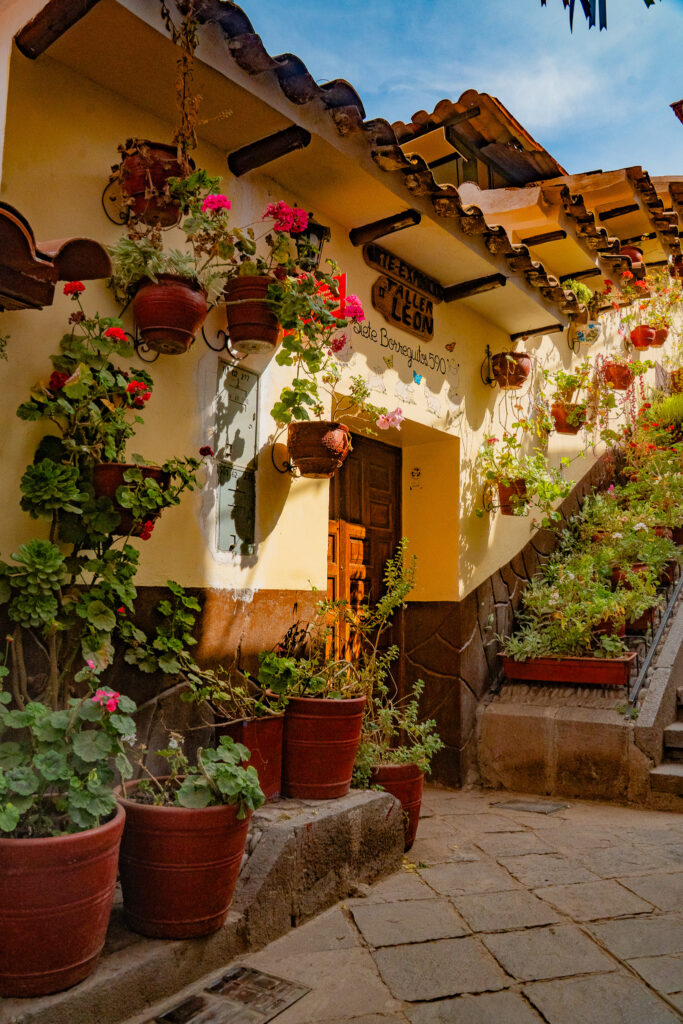
Incan Foundations
Along streets like Hatun Rumiyoc, the massive, precisely cut polygonal stones of Inca foundations are clearly visible. They support the later colonial structures built atop them. This isn’t history confined to museums. The history integrated into the very fabric of the neighborhood. It’s a constant, tangible reminder of the civilizations that have shaped this place. It also speaks volumes about the resilience and continuity of life in this Andean city, where the past is not just remembered but actively lived upon.
Further along Hatun Rumiyoc, embedded within a wall constructed by the Inca Roca, lies the famed Twelve-Angled Stone. Encountered not as a standalone monument but as part of the ongoing streetscape, it offers a moment of profound wonder. The stone’s intricate, perfect fit exemplifies the legendary skill of Inca stonemasons. Its presence here is seamlessly incorporated into a wall that has stood for centuries. It reinforces the narrative of Cusco’s enduring, layered past. It also invites contemplation on the ingenuity and permanence of ancient craftsmanship amidst the flow of daily life.
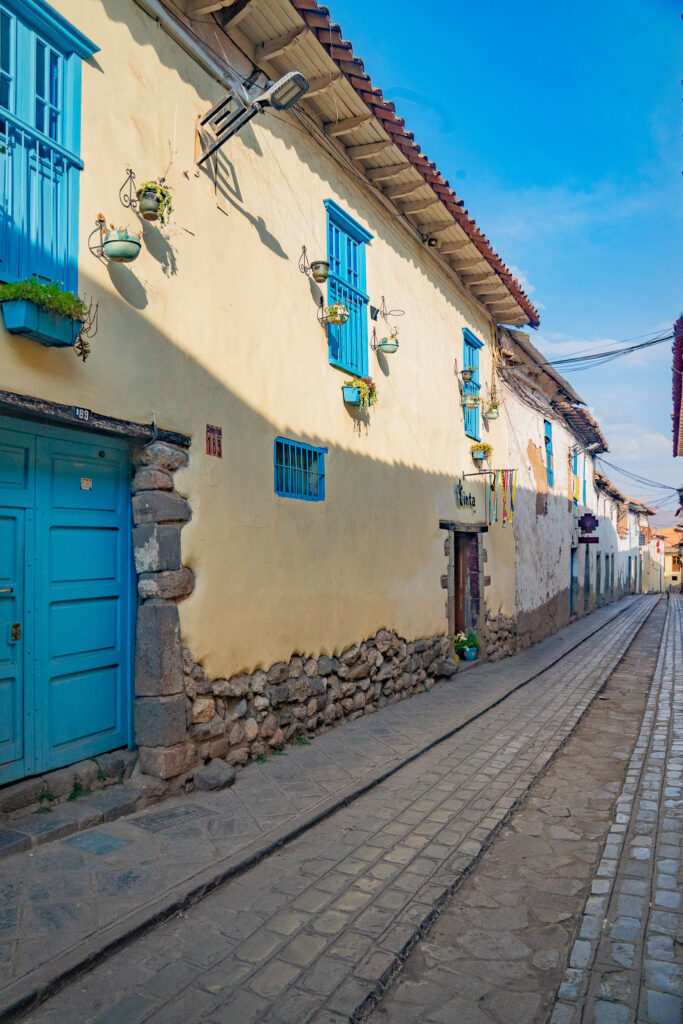
The Artisan Scene of San Blas
As one delves deeper into San Blas, the neighborhood reveals its artistic heart. The feeling is less like visiting a designated arts district and more like stumbling into a living, breathing center of creativity. Hidden workshops and intimate galleries appear unexpectedly. They are tucked away down narrow side alleys or behind unassuming doorways. Art isn’t confined indoors; it often spills out onto the streets. You might find a painter capturing the light at an easel in a quiet corner. There may be rows of ceramics drying out in a sunlit courtyard. Perhaps vibrant textiles adorn an exterior wall, offering flashes of color against the whitewashed adobe.
The diversity of crafts is remarkable, reflecting both deep traditions and contemporary interpretations. Visitors encounter the earthy textures and forms of traditional ceramics, often depicting scenes of local life or ancient motifs. Intricately carved wooden pieces, ranging from expressive masks to detailed religious figures, showcase generations of skill. The vibrant hues of alpaca textiles – scarves, sweaters, blankets – are ubiquitous, alongside gleaming silver jewelry and unique paintings that capture the spirit of the Andes. The sheer concentration of artistry confirms San Blas’s reputation; it’s not merely a place with art, but a place fundamentally defined by it, suggesting a self-sustaining ecosystem where creativity flourishes..
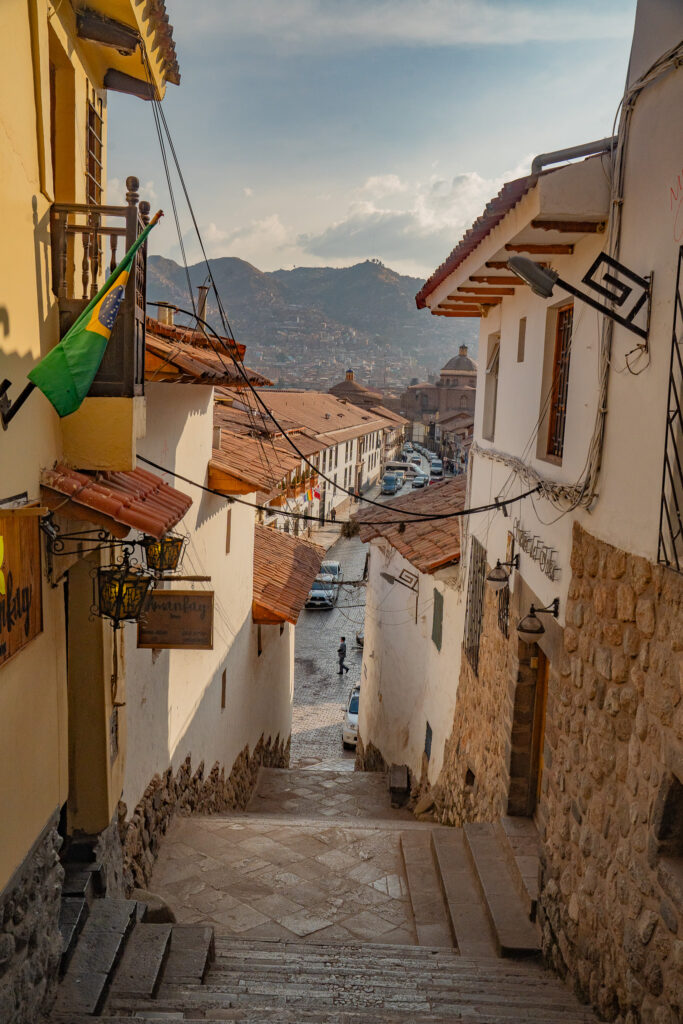
La Plazoleta de San Blas
All paths in San Blas seem to eventually lead to the Plazoleta de San Blas. It is the neighborhood’s charming social and geographical nucleus. This intimate square is smaller and more tranquil than the Plaza de Armas. It also possesses a distinct character. Benches invite repose, often occupied by locals chatting, children playing, or travelers catching their breath. Surrounding the square, artisan shops and cozy cafes spill outwards. Their presence animates the space. On certain days, particularly weekends, a small craft market might add further vibrancy. This offers another opportunity to engage with local artisans. The Plazoleta serves as a beating heart of the neighborhood itself – welcoming, artistic, and gently bustling.
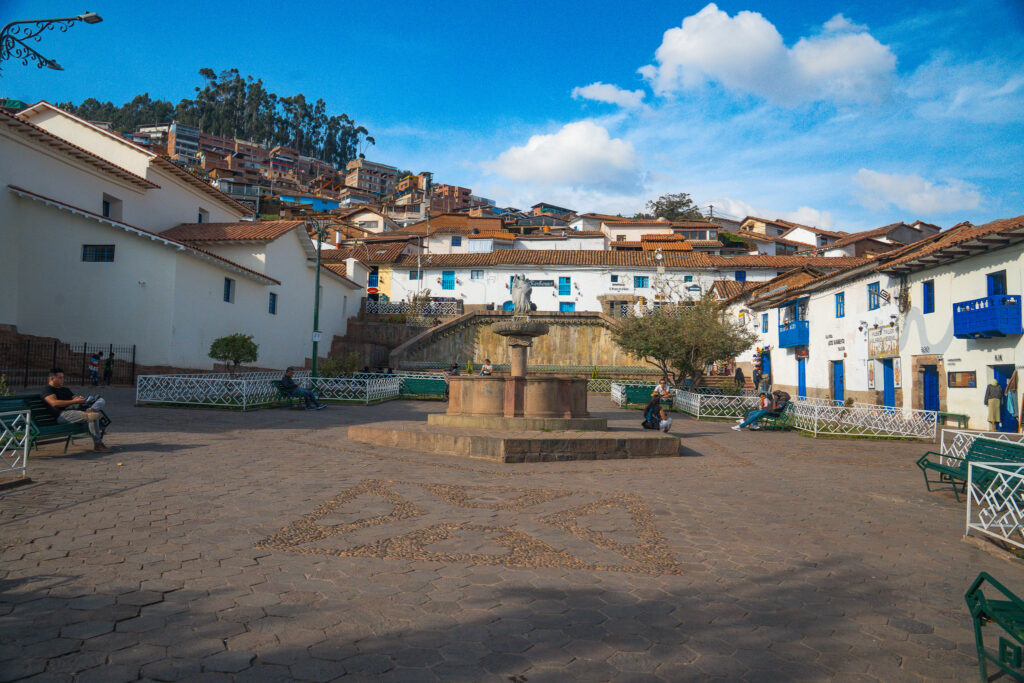
Views from the Balcony of Cusco
The physical exertion of navigating San Blas’s steep streets finds its ultimate reward upon reaching viewpoints like the Mirador de San Blas. From this elevated perch, Cusco unfolds below in a breathtaking panorama. Terracotta rooftops cascade down the hillside, punctuated by the bell towers of colonial churches, all framed by the dramatic backdrop of the surrounding Andean peaks. The view offers not just a stunning visual spectacle but also a sense of perspective, placing the intimate scale of San Blas within the broader context of the sprawling city and the vast mountain landscape. It’s a moment that crystallizes the neighborhood’s role as the “Balcony of Cusco.”
This vantage point is particularly magical during the late afternoon as sunset approaches. The changing light bathes the city in a warm, golden glow, casting long shadows and highlighting the textures of the architecture. Watching the transition from day to twilight over Cusco from the Mirador de San Blas is a quintessential experience, offering a moment of quiet reflection and profound appreciation for the beauty and history encapsulated in the scene below. This culmination provides both a literal high point to the exploration and a metaphorical sense of accomplishment and connection.
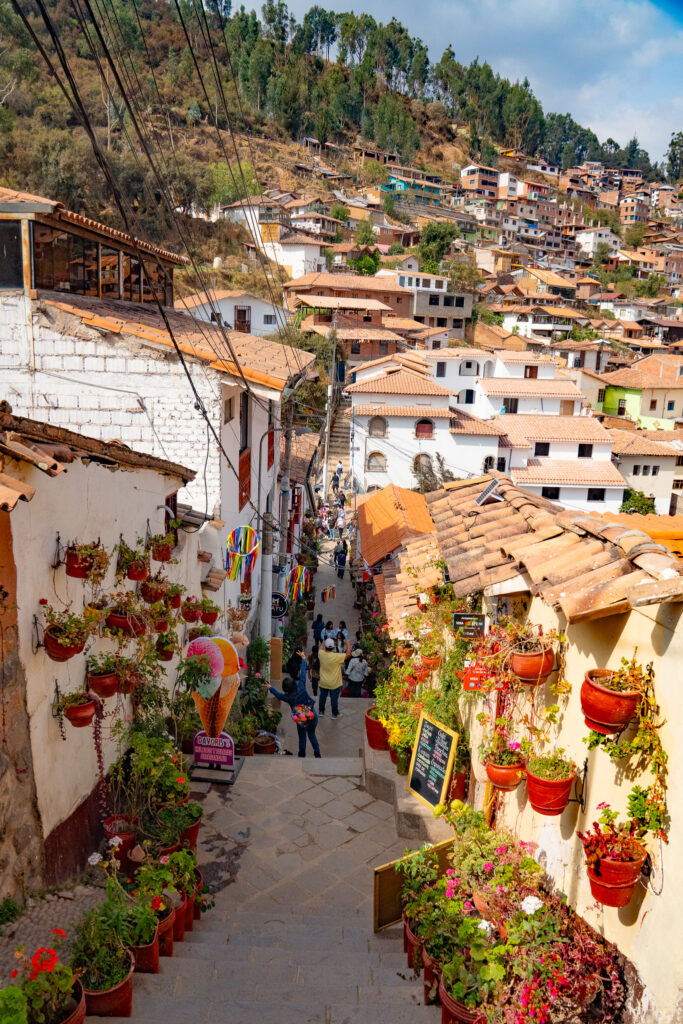
Tips for the Wanderer
To fully embrace the spirit of discovery in San Blas, a few practical considerations can enhance the experience, transforming a simple visit into a true exploration. Timing, for instance, can shape the atmosphere encountered. Visiting in the morning often means quieter streets, softer light for photography, and a more intimate feel. Conversely, exploring in the late afternoon allows visitors to catch the “golden hour” light and potentially culminate their walk with sunset views from the Mirador.
Perhaps the single most crucial piece of advice relates to footwear. The steep inclines and uneven cobblestone surfaces that lend San Blas its historic charm demand comfortable, sturdy walking shoes with good grip. Attempting these streets in inadequate footwear is not only uncomfortable but potentially hazardous. Furthermore, acknowledging Cusco’s high altitude (around 3,400 meters or 11,200 feet) is essential. It’s wise to allow time for acclimatization upon arriving in Cusco before tackling the demanding climbs of San Blas. Taking it easy initially prevents altitude sickness from detracting from the enjoyment. These physical realities, in a way, act as a natural filter, attracting visitors prepared for a more immersive, less rushed style of exploration.
The true magic of San Blas often lies just beyond the main routes. Visitors are encouraged to embrace a spirit of intentional “getting lost”. Daring to wander down narrow side streets and unmarked alleys frequently leads to the discovery of hidden courtyards, smaller, less-visited artisan workshops, quiet residential corners, and unexpected perspectives on the city below. This type of exploration fosters a sense of personal discovery that defines the San Blas experience.

San Blas's Enduring Magic
San Blas is more than just a collection of picturesque streets and artisan shops; it’s an experience that resonates long after the climb down. Its unique essence lies in the seamless blend of palpable history etched into its very stones, the vibrant pulse of living creativity that animates its workshops and galleries, the breathtaking reward of panoramic city views, and an overall captivating, almost timeless atmosphere that feels worlds away from the bustle below. It acts as a microcosm of Cusco itself, concentrating the city’s defining blend of Inca heritage, colonial influence, and enduring Andean culture into one evocative square kilometer.
What truly distinguishes San Blas is the feeling it imparts – a sense of connection to something deeper, more authentic. It invites a slower pace, rewards curiosity, and reveals its secrets gradually to those willing to wander and observe. It’s a place where the past is not just preserved but actively interwoven with the present, where artistic tradition is not just remembered but constantly renewed. For travelers seeking more than just sights, San Blas offers an opportunity to breathe deep, engage the senses, and connect with the enduring soul of Cusco. The call remains: ascend the Cuesta, wander the lanes, discover the artistry, and let the unique spirit of San Blas weave its enchanting spell.


Keep up with my latest adventures in Adventures Unpacked! A newsletter for the wanderlust-filled adventurer with news on my latest journeys, travel and photography tips, and more!